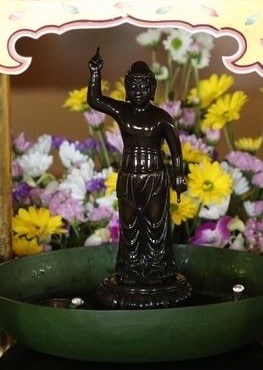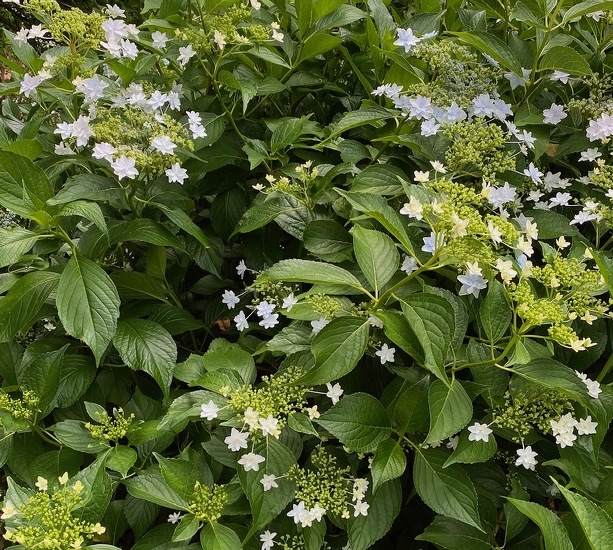April and Uzuki

April in Japan is Shi-gatsu, 4月, Fourth-month, and according to the old calendar the name for the 4th month is U-zuki, 卯月, Hare-moon. It is said that Uzuki is named for the u-no-hana, 卯の花, hare’s flower, which blooms at this time of the year. In 2022, the first day of the 4th month occurred on May 1, which is one month later than April 1.
The plant unohana, in English, is known as deutzia crenata, which is in the hydrangea family, and is called ‘bridal wreath,’ which is a bit misleading for that name is applied to other flowering shrubs. In addition, the Kanji for deutzia also includes utsu-gi, 空木, empty/sky-tree. The shrub has small, white, multiple petals that are in clusters. When in bloom it is likened to snow, and is often depicted with shiro-usagi, 白兎, white rabbits.

The Kanji for u, 卯, is for the zodiac sign of the Hare: the Kanji for the animal is usagi, 兎. The Kanji is also identified with the east, the year, the day, the time from 5 to 7 am, etc. The Kanji, 卯, has other meanings including to pour out, to empty (hence the Kanji utsu, 空), and mortise.
These translations may be related to an incident in the month of the fourth moon. The Buddhist guardian of the sign of the Hare is Mon-ju Bo-satsu, 文殊菩薩, Literary-exceptional Sacred tree-buddha, who represents transcendent wisdom. He is often paired with Fu-gen Bo-satsu, 普賢菩薩, Universal-wisdom, and together they accompany Sha-ka Butsu, 釈迦仏, Explain-(sound), the historical Buddha.
The most important event in the 4th month of the Buddhist calendar is the birth of the Buddha, which occurred on the 8th. In Japan, this is called Kan-butsu-e, 灌仏会, Libate-Buddha-assembly, and Hana Matsuri, 花祭, Flower Festival. Another name for the observance is Ryū-ge-e, 龍華会, Dragon-flower-assembly. The flower is the lotus, which is sacred to Buddhism.
The principle act of the rites is to pour ama-cha, 甘茶, sweet-tea, with a hi-shaku, 柄杓, handle-ladle, over standing images of the newborn Buddha. The image, often made of bronze, is set in the center of a wide basin filled with amacha, placed in a small pavilion with a roof, adorned with artificial flowers, supported on four pillars. The structure is called the hana-mi-dō, 花御堂, Flower-honor-hall, which is also the origin of the term, Flower Festival. Legend has it that the rite is derived after the birth of the Buddha, when nine dragons poured pure water from heaven. This is also the reason it is called Dragon-flower-assembly.

The amacha is made from the leaves of the yama ajisai, 山紫陽花, mountain purple-Yang-flower, (Hydrangea macrophylla subsp., Serrata), mountain hydrangea. A variety of lace cap, the leaves have beneficial medical properties containing phyllodulcin and iso phyllodulcin. The sweetness of the leaves is said to be hundreds of times greater than sucrose.
The Kanji for hydrangea, 紫陽花, read ajisai appears to have no connection with the characters. Kanji that are more likely to be read ‘ajisai’ are, 味采, flavor-leaf, as the leaves are very sweet. However, most leaves have flavor. The etymology of ‘hydrangea’ is ‘water vessel’, which comes from the form of its seed pod. The plants require a great amount of water for the plant to flourish, and the ajisai flowers are emblematic of the rainy season in Japan.
The yojōhan tearoom may be identified with various traditional aspects including solar and lunar calendars. The 4th moon of the lunar calendar in the yojōhan is located on the south wall toward the east, which is the location of the nijiri-guchi, 躙口, crawl in-opening. This location corresponds with the lunar 4th month and specifically with the 8th day, and the birth of the Buddha. One enters the Tearoom crawling through the small nijiri-guchi that is identified with Buddha’s birth date.
Anointing the image of the infant Buddha is a form of libation, and in Japanese is kan or matsuri, 祼, libation. The word libation comes from Latin libare, to pour out. This is the same as meaning of the Kanji for ‘u’, 卯, which means to pour out. This may be the true origin of uzuki, the month for libation of the Buddha.
The nijiri-guchi is located in the southeast corner of the Tearoom which is guarded by the Buddhist deity, Fugen. The southeast is marked with the zodiac sign of Tatsu-Mi, 辰巳, Dragon-snake – at his birth, the Buddha was anointed by heavenly dragons. The nijiri-guchi is the sole opening in the wall of the Tearoom through which a person enters or leaves the room.
The 4th month is also named Utsugi, 空木, and the Kanji 空 means empty, open, sky, and the Buddhist concept of the Void, which is one of the Go-rin, 五輪, Five-rings, principles. The Kanji for gi or ki, 木, meaning tree or wood, is one of the Go-gyō, 五行, Five-transitions, physical elements. The concept of the Void is the intangible positive, Yō aspect, counterpart of Wood, that is the physical negative, In aspect. The nijiri-guchi has as a sliding wooden door that changes the passage from open to closed.
For further study, see also: April: Bells and Kuzu, Tea in April, April in Japan: Following Elephants

